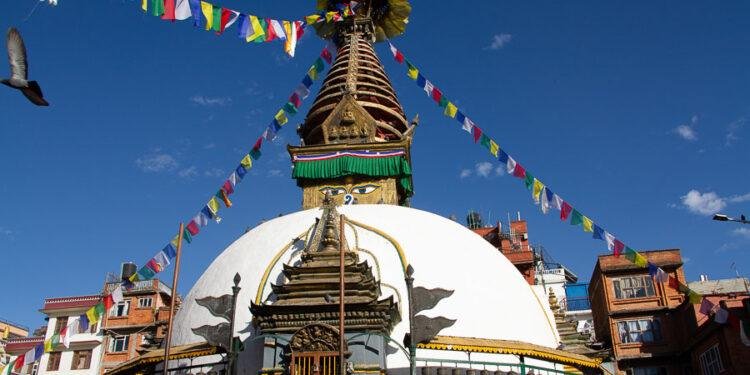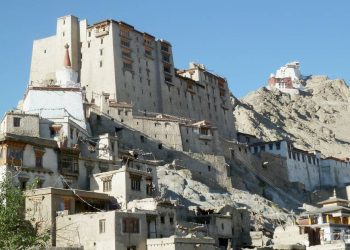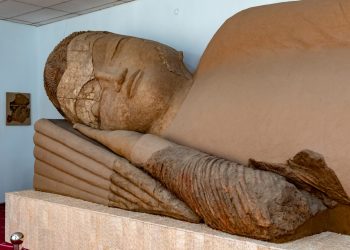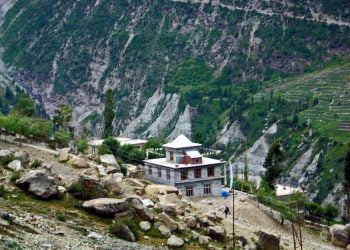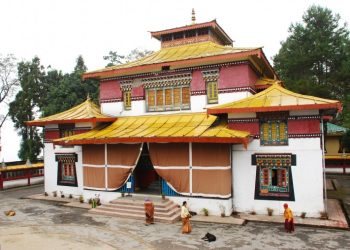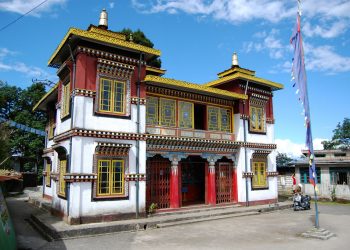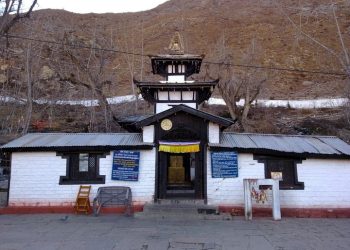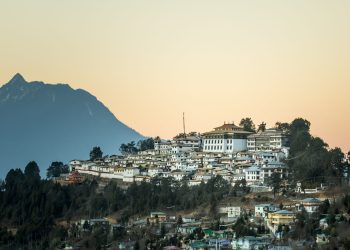Introduction to Kathesimbhu Stupa
Nestled within the vibrant city of Kathmandu, the Kathesimbhu Stupa stands as a serene oasis reflecting the rich cultural heritage of Nepal. Located in the bustling area of Bhaktapur, this stupa is often overshadowed by the more prominent Swayambhunath, yet it presents a unique charm that attracts visitors seeking tranquility amidst urban chaos. Kathesimbhu Stupa is easily accessible, making it an excellent addition to any itinerary for those exploring the historical avenues of Kathmandu.
The significance of Kathesimbhu Stupa extends beyond its aesthetic appeal; it is a sacred site revered by both locals and tourists. It showcases traditional Buddhist architecture and symbolizes the deep-rooted spiritual beliefs prevalent in Nepal. Unlike the larger Swayambhunath, well-known for its expansive views and numerous monkeys, Kathesimbhu offers a more intimate setting where one can reflect and engage in meditation with fewer distractions. The modest size of this stupa allows visitors to appreciate its artistry and historical narrative without feeling overwhelmed.
One of the most compelling features of Kathesimbhu Stupa is the peaceful atmosphere that envelops it. The site is surrounded by lush greenery and offers a captivating vista of the city, contributing to the tranquil environment that invites contemplation and inner peace. Visitors often describe their experience at Kathesimbhu as a refreshing counterpoint to the lively streets of Kathmandu. This hidden gem not only enriches one’s understanding of Buddhist traditions but also provides a necessary respite from the hustle and bustle of the city, making it a worthwhile destination for those seeking solace and spiritual connection in the heart of Nepal.
Historical Background
The Kathesimbhu Stupa, a significant and serene monument in Kathmandu, boasts a rich historical narrative that stretches back to its construction in the 17th century. The stupa was built during a time when Buddhism was flourishing in the region, primarily under the patronage of local rulers. This dedication to spiritual pursuits led to the establishment of a number of stupas and monasteries, with Kathesimbhu being one of the most notable.
Constructed in 1665 by the then King of Nepal, Pratap Malla, the stupa reflects the architectural influences of both Tibetan and Newari styles, showcasing a harmonious blend that distinguishes it from other religious structures in Kathmandu. The stupa’s design incorporates traditional elements such as the mandala shape, symbolizing the universe, along with intricate carvings and vibrant murals that depict various aspects of Buddhist teachings. This architectural fusion not only underscores the aesthetic sensibilities of the time but also illustrates the cultural exchanges between different religious communities.
Over the centuries, Kathesimbhu Stupa has undergone several restorations, particularly following damages incurred during the 1934 earthquake, and again after the 2015 earthquake. Despite these challenges, the stupa has retained its significance as a pilgrimage site for both locals and tourists. It continues to serve as a place of meditation and reflection, where visitors engage with the spiritual heritage of the area. The stupa’s unique history and enduring presence in Kathmandu encapsulate the essence of the city’s identity, depicting how the past continues to influence contemporary cultural practices. Factors such as ongoing rituals and community involvement have ensured that the Kathesimbhu Stupa remains a vital part of Kathmandu’s cultural landscape.
Architecture and Design
The Kathesimbhu Stupa stands as an exemplary representation of traditional Nepalese Buddhist architecture, showcasing intricate design elements that are both functional and deeply symbolic. Primarily known for its prominent stupa, the structure encapsulates the essential elements of a stupa’s architecture, characterized by its domed shape and a square base, symbolizing the universe. The central structure is topped with a harmika, a rail-like enclosure that reflects the celestial realms, and is adorned by a finely crafted chhatra (umbrella), representing the protection of the Buddha’s teachings.
Surrounding the main stupa, colorful prayer flags flutter in the wind, enhancing the aesthetic and religious ambiance of the site. These flags, known as “lung ta” in Tibetan, are a traditional motif found throughout Nepal, believed to promote peace, compassion, and strength. Their vibrant colors celebrate the elements of nature, which resonates deeply with the Buddhist philosophy of harmony with the environment. The placement of these flags is not merely decorative; they serve a spiritual purpose, as prayers and mantras are printed on them, intended to be carried away by the wind.
Another striking element of Kathesimbhu Stupa’s design is its extensive use of stone carvings and ornate murals, which narrate tales from the life of the Buddha and other significant figures in Buddhist history. Comparatively, the architectural style bears similarities to Swayambhunath, another famed Stupa in Kathmandu. Both structures, while unique, embrace the principles of stupas with simplified forms and interwoven spiritual symbology. The subtle distinctions in their design and execution reflect the regional influences and materials prevalent in their respective constructions, making Kathesimbhu a fascinating study in Nepalese architectural evolution.
Wildlife and Surroundings
The Kathesimbhu Stupa, located in the heart of Kathmandu, is not only an architectural marvel but also a refuge for a diverse range of wildlife, particularly pigeons. These birds are a common sight around the stupa, creating a vibrant atmosphere that reflects the synergy between nature and spirituality. Visitors often find themselves captivated by the gentle cooing of the pigeons as they flutter around, complementing the serene ambiance that the stupa emanates.
The presence of these birds is significant, as they embody the spiritual essence of the site, contributing to the overall tranquility that envelops the area. Pilgrims and tourists alike find solace in watching the pigeons as they interact with their surroundings, pecking at grains offered by devotees and fluttering overhead against the backdrop of the stupa’s impressive architecture. The stupa acts as a sanctuary, providing an ideal habitat for these birds, where they feel safe from the hustle and bustle of urban life.
Furthermore, the quieter location of Kathesimbhu Stupa enhances this relationship between wildlife and the site. Tucked away from the more crowded tourist attractions, it offers a peaceful retreat where visitors can engage with their spirituality while being in tune with nature. The lush greenery surrounding the stupa contributes to its serene environment, making it an ideal spot for quiet reflection or meditation. This natural setting serves not only as a backdrop but also as a vital part of the overall experience that the stupa offers, bridging the natural world with the sacred.
In conclusion, the wildlife, particularly the pigeons, populating the Kathesimbhu Stupa, harmonizes beautifully with its surroundings, offering a peaceful atmosphere that enriches the spiritual experience for all who visit. The stupa stands as a testament to the interconnectedness of nature and spirituality, inviting individuals to appreciate the simple yet profound relationship shared within this hidden gem of Kathmandu.
Visiting Tips
When planning your visit to Kathesimbhu Stupa, timing can significantly enhance your experience. The best times to visit are during the early morning or late afternoon, as these hours typically provide a more serene atmosphere with fewer crowds. The light during these times is also ideal for photography, capturing the stupa surrounded by soft, golden hues.
To reach Kathesimbhu Stupa from popular areas, such as Thamel or Kathmandu Durbar Square, various transportation options are available. Thamel is roughly a 20-minute walk away, making it a pleasant stroll through the streets of Kathmandu, where one can soak in the vibrant local culture. Alternatively, hiring a taxi is a convenient option, taking approximately 10 minutes, depending on traffic conditions. For visitors coming from Kathmandu Durbar Square, the stupa is about a 15-minute walk, offering opportunities to explore nearby temples and shops along the way.
Upon arrival, expect a peaceful environment, especially in the early hours. Kathesimbhu Stupa is often less crowded than more popular sites, allowing visitors to fully appreciate the intricate details of the stupa and the surrounding area. Accessibility is generally adequate; however, visitors should be aware that the pathway leading to the stupa may have uneven surfaces. For those with mobility challenges, careful planning is recommended, as navigating through the area might require assistance or extra time.
Additionally, it’s essential to respect local customs while visiting. Dress modestly, remove your shoes before entering the sacred areas, and maintain a quiet demeanor to preserve the tranquility of this spiritual site. With thoughtful preparation, your visit to Kathesimbhu Stupa will undoubtedly be a memorable experience, filled with serene moments and cultural insights.
Nearby Attractions
Visitors to the Kathesimbhu Stupa are often pleasantly surprised by the plethora of nearby attractions that enhance the cultural and historical experience of the area. The stupa itself, a notable Buddhist shrine, is surrounded by several significant sites that are worth exploring. One of the most prominent nearby attractions is the Kopan Monastery, located just a short distance away. Renowned for its serene atmosphere and stunning views of the Kathmandu Valley, this Tibetan Buddhist monastery offers insight into meditation practices and the spiritual heritage of the region. Visitors can attend courses or simply stroll the grounds, absorbing the tranquility that the monastery provides.
In addition to Kopan Monastery, the area surrounding the Kathesimbhu Stupa is rich in arts and crafts shops, showcasing local talent and craftsmanship. These small boutiques and galleries provide an opportunity for visitors to purchase traditional handicrafts, including handmade textiles, intricate wood carvings, and beautifully crafted metal works. Engaging with local artisans not only supports the community but also adds a unique touch to the overall visit, giving tourists a chance to take home a piece of Nepalese culture.
Nearby, visitors can also discover the historic Bhaktapur Durbar Square, a UNESCO World Heritage site that features stunning examples of Newari architecture and craftsmanship. The square is home to numerous temples and palaces that narrate the rich history and cultural evolution of Nepal. A visit to this area complements the meditative experience at Kathesimbhu Stupa, providing a broader understanding of the historical and spiritual landscape of Kathmandu. The combination of these attractions makes the Kathesimbhu Stupa an ideal starting point for a more immersive exploration of the city’s cultural treasures.
Cultural Significance
The Kathesimbhu Stupa, nestled within the bustling surroundings of Kathmandu, serves as a cherished spiritual landmark in the local community. With its origins deeply rooted in both Buddhism and the rich history of the Kathmandu Valley, this stupa embodies the cultural and religious fabric of the area. The stupa stands not only as a monument but also as a focal point for various local practices and rituals that connect the residents to their spiritual heritage.
Each year, numerous ceremonies are held at Kathesimbhu Stupa, attracting practitioners and visitors alike. Local residents often partake in rituals such as circumambulating the stupa, a practice that symbolizes devotion and mindfulness in Buddhist traditions. This act fosters a sense of community among worshippers, as it encourages them to walk together around the stupa while offering prayers, the lighting of lamps, and the placing of prayer flags, thereby reinforcing their collective spiritual involvement.
Moreover, the stupa is integral to numerous festivals that celebrate Buddhist teachings and cultural narratives. Events like Buddha Jayanti, which commemorates the birth of Buddha, see the stupa become a vibrant gathering place for practitioners who engage in prayers, chant hymns, and share communal meals. Such festivities not only highlight the stupa’s role as a spiritual center but also enhance its significance as a cultural hub where traditions are passed down through generations.
Additionally, the nearby community utilizes the stupa as a place for meditation and reflection. In an increasingly urbanized environment, the Kathesimbhu Stupa offers moments of tranquility for individuals seeking solace and spiritual connection. As such, it serves as a bastion of peace amidst the hustle of city life, allowing residents to foster their spiritual well-being.
Personal Experiences
The Kathesimbhu Stupa, often overlooked by tourists, has become a sanctuary for many who seek solace in the bustling heart of Kathmandu. Visitors frequently recount their experiences of serenity as they approach this hidden gem, often describing it as a stark but refreshing contrast to the lively streets surrounding it. One traveler noted how the gentle sound of chanting monks juxtaposed with the distant hum of the city created an atmosphere that was both meditative and uplifting. The serene environment allows individuals to retreat from their hectic schedules and immerse themselves in a moment of tranquility.
Another visitor captured the charm of Kathesimbhu Stupa during an early morning visit. As the first rays of sunlight illuminated the stupa, the sight was breathtaking. The visitor described feeling an overwhelming sense of peace wash over them, as if time had stopped momentarily. This experience, enhanced by the soft flicker of butter lamps and the delicate aroma of incense in the air, left an indelible mark on their memory. The sense of community among fellow visitors and devotees added to the unique charm of the site, as strangers exchanged smiles and nods, united in their shared appreciation for the beauty surrounding them.
Conclusion
Kathesimbhu Stupa stands as a tranquil oasis amidst the hustle and bustle of Kathmandu, providing a compelling blend of cultural richness and serene beauty. As we have explored, this hidden gem is not only an architectural marvel but also a spiritual haven that attracts both locals and tourists seeking respite from the frenetic pace of city life. The stupa’s unique Tibetan-inspired design, complete with intricate carvings and vibrant prayer flags, offers visitors a glimpse into the profound significance of Buddhist traditions that permeate the area.
Moreover, the location of Kathesimbhu Stupa enhances its allure, nestled within the vibrant vibes of the city yet offering a peaceful retreat for those who wish to reflect and unwind. Its relatively lesser-known status means that visitors often experience a more intimate ambiance, allowing for personal moments of contemplation or simply enjoying the serene surroundings. The panoramic views of the stupa against the backdrop of Kathmandu create a picturesque landscape that deserves to be appreciated by anyone traversing through the city.
In light of the insights shared, we encourage readers to consider adding Kathesimbhu Stupa to their itineraries. This sacred site represents not just a destination, but an experience deep-rooted in the heart of Nepalese culture and spirituality. Whether you are looking to meditate, take in the historical significance, or just escape the urban chaos, Kathesimbhu offers an enriching experience. On your next journey to Kathmandu, take the time to visit this lesser-known treasure and immerse yourself in the peaceful atmosphere that holds the essence of its rich heritage.





































